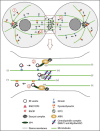Endosomal recycling regulation during cytokinesis
- PMID: 19907714
- PMCID: PMC2775247
- DOI: 10.4161/cib.2.5.8931
Endosomal recycling regulation during cytokinesis
Abstract
Successful cytokinesis is critical for cell proliferation and development. In animal cells, cytokinesis relies on temporally and spatially regulated membrane addition to the cleavage site. An important source for the new membrane is recycling endosomes. Yet how these endocytic vesicles are transported and regulated remains unclear. Several potential factors have been recently identified that regulate the trafficking of recycling endosomes during cytokinesis. Dynein and dynactin are required for the retrograde transport of recycling endosomes, while Kinesin-1 is responsible for endosome delivery to the furrow and midbody. Other regulators of recycling endosome trafficking have been identified, including RACK1, JIP3/4 and ECT2, which target recycling endosomes during the cell cycle. Here, we provide insights into the mechanisms controlling endosomal trafficking during cytokinesis.
Keywords: ARF6; JIP4; RAB11; RAB11FIP3; RACK1; cytokinesis; dynactin; dynein; kinesin; membrane trafficking; recycling endosomes.
Figures

References
Grants and funding
LinkOut - more resources
Full Text Sources
